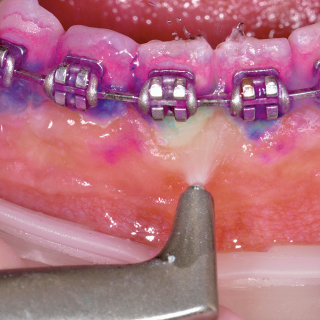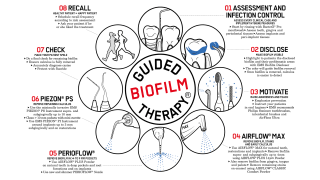The orthodontic patient -
From hell to heaven
Tabitha Acret explains how Guided Biofilm Therapy has revolutionised how she treats orthodontic patients
If you’re anything like me, my heart would sink a little when I would see that a teenage patient in active orthodontics was booked to see me. Who would walk through the door? Would it be a mouth full of food debris stuck in what looked like moldy orthodontic brackets and profusely bleeding gums? Would I see impossible to reach staining around the brackets or think my patient just ate a packet of Cheezels™ only to find out that he or she had just not brushed his teeth since the last time I saw them?
I used to loath this type of patient, not just because I could find enough food in their brackets to feed a small nation but because I was never satisfied with the results I’d achieved after I’d finished their clean. Far too often, I felt under pressure to get their teeth cleaned in the “child” timed appointment slot, never feeling like I had removed everything.
I was always feeling frustrated trying to manoeuvre my ultrasonic tip around brackets, trying to use a prophy handpiece and gluggy prophy paste to remove tenacious sticky mature plaque from modules and on the gingival side of the bracket. As I frantically worked away, I would be loathing the patient in the chair; blood, sweat and tears from both of us was going into the appointment with a lacklustre result!
Good oral hygiene is paramount to successful orthodontic treatments. Without good oral hygiene, a patient’s outcome will be compromised. This was frustrating me. In a journal article by Lovrov S, et al (2007),1 it was shown that “despite improvements in materials and preventative efforts, orthodontic treatments continue to carry considerable risk of enamel demineralisation. Each patients’ prophylactic efforts, including fluoride use are of paramount importance in preventing white spot lesions”. In another article, by Ren, et al (2014),2 it showed that “high treatment demand and the occurrence of biofilm-related complication requiring professional care, make orthodontic treatments a potential public health threat”. Knowing how important it is that the professional clean be good and all biofilm be removed just added to my stress. I knew that I could never remove all the biofilm and that there would be areas around the brackets my ultrasonic or prophy cup just couldn’t get to. Then, if you add in the mix that the patient already has some demineralisation of the enamel where the ultrasonic couldn’t be used, then the frustration and difficulty of the appointment just doubled again.
Combining all of the above problems made me want a better solution. I want to provide my patients with the best treatment possible and I don’t want my patients leaving their appointments with biofilm still trapped in modules. After initially discovering success with AIRFLOW® (EMS) for implant patients, I was interested in what it could offer my orthodontic patients. What I discovered is that by using AIRFLOW in combination with Guiding Biofilm Therapy, I was getting amazing results. If you had asked me before AIRFLOW to plaque disclose my ortho patients, I may have thought you were either crazy or you hated me. Before AIRFLOW, I didn’t want to plaque disclose my patients who have orthodontic appliances as it would have provided proof of the areas where I left biofilm behind because I couldn’t get to it. I now plaque disclose every single one of my patients as part of the “8 steps” of the Guided Biofilm Therapy protocol.
By using the Guided Biofilm Therapy protocol, you achieve predictable biofilm removal with 100% and 360 degree accessibility. It’s safe and effective around the sulcus, there is no change in the surface of the appliance and not only is it more comfortable for the patient with better results, I am happy!
I feel so much happier with my results not only at the time of the appointment but because the long term benefits for the patient in terms of motivation and education are so much better. Not only do the patient and I see better results, but it is also clinically proven that using a plaque disclosing solution to guide biofilm removal shows better outcomes for the patient.
In Botti et al 2010,3 Bastendorf et al 2016,4 and Viorica et al 2013,5 all confirm higher efficiency in professional prophylaxis when done with the use of a disclosing agent. In the study by Viorica et al, Dental Plaque - Classification, Formation and Identification,5 it was shown that “dental plaque diagnosis using coloured solutions is one of the easiest and fastest ways to diagnose dental plaque, which favours its subsequent removal under permanent control during the intervention.
Using AIR-FLOW, removal of dental plaque approaches a ratio of 100%”.
The are two other key reasons why following the Guided Biofilm Therapy protocol is impressive for orthodontic patients as well as routinely in all prophylaxis procedures. The first is the long term health of the enamel and gingiva. By using AIRFLOW technology combined with AIRFLOW PLUS powder, I know that I am providing the least damage to the patients enamel and orthodontic appliances. In A clinical comparison of the efficacy and efficiency of two professional prophylaxis procedures in orthodontic patients,6 Ramaglia et al show that “In orthodontic patients, use of AIRFLOW polishing is a lot safer, efficient and effective to remove stains and dental plaque in comparison to rubber cups and pumice”. The second great thing was that I now had time to finish within the appointment time. I wasn’t feeling so under the “pump”. I used to find that I was always running late in these appointments and now I was finishing easily within the time allocated. In Effects of an air-powder polishing system on orthodontically bracketed and banded teeth,7 Barnes et al show hat “Air polishing around orthodontic brackets and bands was not only effective but time efficient. There were no detrimental effects to any composite material or cement in comparison to rubber cup and pumice”.
By using Guided Biofilm Therapy with AIRFLOW technology combined with appropriate home OHI instructions and motivation, I am providing the best treatments possible for my patients. I love Guided Biofilm Therapy; it’s changed my attitude toward treatment, my treatment results and my patients’ long term outcomes. Guided Biofilm Therapy is evidence-based dentistry; it is the new standard of care we should all be looking to reach.
Tabitha Acret is a qualified dental hygienist and has been part of the dental industry for 20 years. She has worked as a dental nurse, dental receptionist and practice manager. She holds a BOH from Newcastle University and is currently undertaking further studies in Sleep Medicine. Tabitha is registered with the Australian Dental Board and was the previous chair for the NSW Dental Hygienist Association Australia Ltd and is the current NT Director for the DHAA Ltd. She is a regular at CPD events with a passion for learning and making a difference in her patients’ lives. Tabitha currently works 3 days a week in private practice, was a previously a clinical educator one day a week at Sydney University for 2nd year BOH students until her recent move to the Norther Territory to help set up an implant maintenance program in private practice. Tabitha is also an educator with the Swiss Dental Academy
1. Lovrov S, Hertrich K, Hirschfelder U. Enamel Demineralization during Fixed Orthodontic Treatment - Incidence and Correlation to Various Oral-hygiene Parameters. J Orofac Orthop. 2007 Sep;68(5):353-63. 2. Ren Y, Jongsma MA, Mei L, van der Mei HC, Busscher HJ. Orthodontic treatment with fixed appliances and biofilm formation - a potential public health threat? Clin Oral Investig. 2014 Sep;18(7):1711-8. 3. Botti RH, Bossù M, Zallocco N, Vestri A, Polimeni A. Effectiveness of plaque indicators and air polishing for the sealing of pits and fissures. Eur J Paediatr Dent. 2010 Mar;11(1):15-8. 4. Schwarz F, Becker K, Bastendorf KD, Cardaropoli D, Chatfield C, Dunn I, Fletcher P, Einwag J, Louropoulou A, Mombelli A, Ower P, Pavlovic P, Sahrmann P, Salvi GE, Schmage P, Takeuchi Y, Van Der Weijden F, Renvert S. Recommendations on the clinical application of air polishing for the management of peri-implant mucositis and peri-implantitis. Quintessence Int. 2016 Apr;47(4):293-6. doi: 10.3290/j.qi.a35132. 5. Chetrus V, Ion I.R. Dental Plaque - Classification, Formation and Identification. Int J Med Dent. Apr-Jun 2013, Vol. 17 Issue 2, p139-143. 5p. 6. Ramaglia L, Sbordone L, Ciaglia RN, Barone A, Martina R. A clinical comparison of the efficacy and efficiency of two professional prophylaxis procedures in orthodontic patients. Eur J Orthod. 1999 Aug;21(4):423-8. 7. Barnes CM1, Russell CM, Gerbo LR, Wells BR, Barnes DW. Effects of an air-powder polishing system on orthodontically bracketed and banded teeth. Am J Orthod Dentofacial Orthop. 1990 Jan;97(1):74-81.




